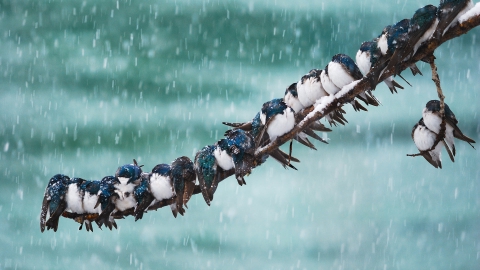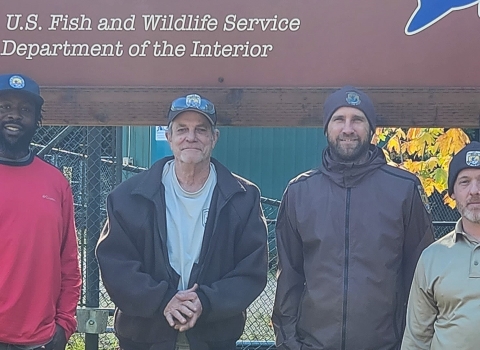What’s the trick to weathering winter’s icy grip? There’s no single answer. Here are a few strategies that work for wildlife on national wildlife refuges. Some species employ more than one strategy. See if some surprise you.
One classic response before winter comes howling at your door: Clear out. As temperatures drop and food resources shrink, many bird species head south to more hospitable climes. So do insects, whales, elk and caribou.
Around National Elk Refuge in Wyoming, elk migrate down from the high country to the valley floor where snow is less deep.
In Alaska, some caribou herds log thousands of miles a year between winter foraging grounds and summer calving grounds.
More on why animals migrate.
Group hug! Some animals rely on one another to weather winter’s wrath. The snuggle-up strategy even has a scientific name: kleptothermy. That means stealing body heat from others. But it’s more like sharing than stealing.
The trick for some birds is to get close enough to share warmth but not so close as to compress feathers and reduce insulation. Other animals that huddle for warmth include penguins, bats and sea lions.
Contrary to popular belief, sea cows or manatees do not use this strategy.In winter, great numbers of manatees often huddle in warm springs at Crystal River National Wildlife Refuge in Florida. But for the aquatic mammals, “congregating in large numbers does not confer additional body heat,” says Okefenokee National Wildlife Refuge manager Michael Lusk, who formerly led Crystal River Refuge. “The only reason they gather so closely together is because the area available around the springs is so small.”
Stay alert for other species congregating in winter. Okay, that’s not just a winter strategy. Cooling your jets and keeping a respectful distance are smart practices whether you’re on foot (or hoof) or behind the wheel.
“Wildlife collisions involving multiple species are, unfortunately, very common,” says Lori Iverson, visitor services manager at National Elk Refuge. “A general key message should be to always be on the lookout for wildlife and always give them their distance.”
Turtles, like other ectotherms (the scientific name for cold-blooded animals), have body temperatures that are set by outside conditions. When outdoor temperatures drop, turtle activity slows. This includes eating.
Snapping turtles submerge themselves in lakes and ponds as these bodies of water freeze from the top down.
Snapping turtles breathe through their skin, drawing oxygen from the water through their throat cavity and their cloaca — what you might think of as their butts.
As oxygen in the water gets used up, the turtles switch their metabolism to low-oxygen mode. Turtles can stay submerged for more than 100 days.
More on turtles submerged under the ice here and here.
Mussing your top feathers does more than make you look like Brad Pitt. Fluffing feathers traps air that you can warm with body heat.
The more trapped air, the more heat generated.
How much of a difference could that make? Well, factor in the tens of thousands of feathers on many birds, and going puffy has a distinct advantage in winter. Many feathers are the short fluffy kind — what we call down — which excels as insulation.
Shivering also helps generate heat.
More about making the most of feathers.
Fatten up and sleep: That’s the winter strategy of black bears, as well as some smaller mammals such as groundhogs and skunks.
Keeping the body warm during an extended winter sleep takes energy. Black bears prepare by making hefty deposits into their calorie banks in late summer and fall. They load up on berries, nuts, fish, insects and rodents, gaining up to 30 pounds per week.
In hibernation, black bears drop their heart rate from 55 to 9 beats per minute and slow their metabolism by 53 percent, according to a study by researchers at the University of Alaska, Fairbanks. Remarkably, hibernating bears don’t defecate or urinate, recycling their waste products into amino acids for as long as six months.
Hear a hibernating black bear snore.
Other mammals that use their fat to advantage in winter include walruses.
Not all bears hibernate. Polar bears — especially males — often opt out. They employ what you might call a stealth strategy for winter.
They absorb the sun’s light and heat into their black skin. Yes, you read that right. Under what appears as white fur — but is actually clear — polar bears have evolved to have black skin. That’s best for absorbing energy from the sun.
The long hollow hairs on the bear’s body reflects light, so the bears appear white.
More about polar bear skin and fur.
Now here’s a strategy that won’t work for everyone: freeze.
While most frogs wait out the winter under water, wood frogs in northern forests hunker down on the forest floor and turn into solid blocks of ice.
These cold-blooded animals somehow survive prolonged freezing and later thawing without drying out or sustaining severe damage to body tissues. They do this by producing a substance that acts as an antifreeze to protect their cell linings.
Some freeze for up to eight months a year. That’s eight months without breathing, without eating, without getting oxygen to blood vessels.
Learn more here.
Changing habits is hard — even when your old ones don’t serve you.
Opossums hole up for winter in grass-and-leaf-lined dens — including other animals’ abandoned lairs. But then they go and sabotage their own interests.
The problem is: Opossums don’t stay put. Something propels them to change nests as often as several times a week. A cold winter will often leave opossums with frostbite on their hairless ears and tails. If they live two years, that’s unusual.
More about opossums.














